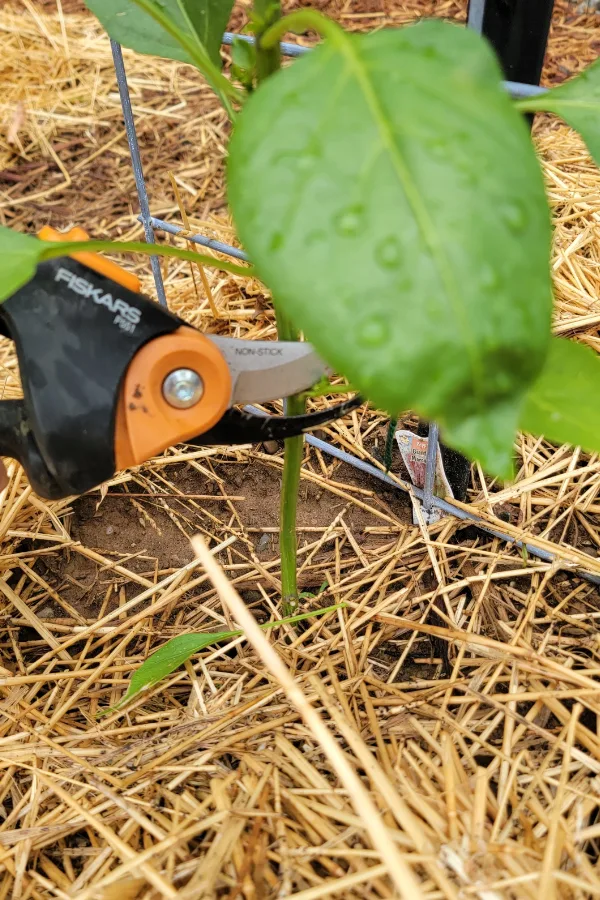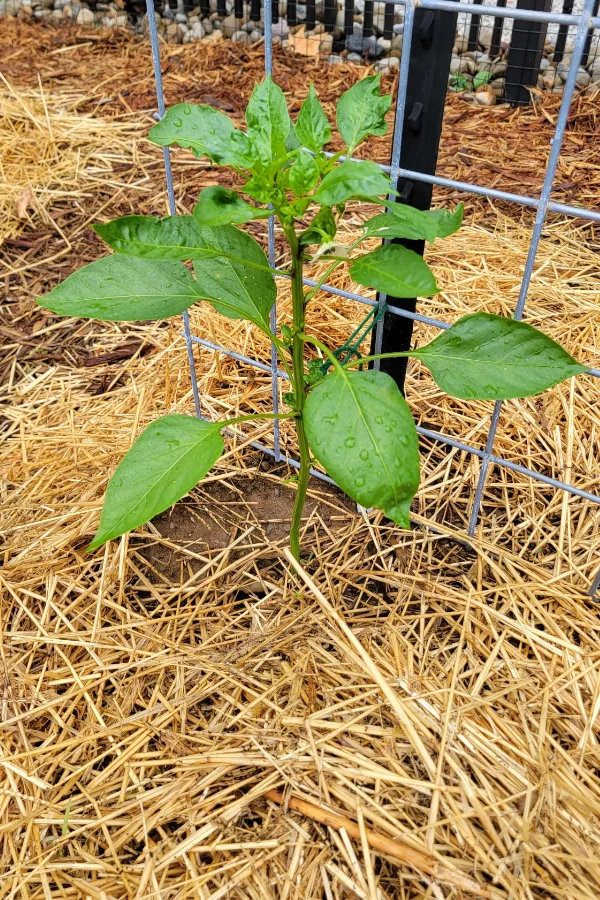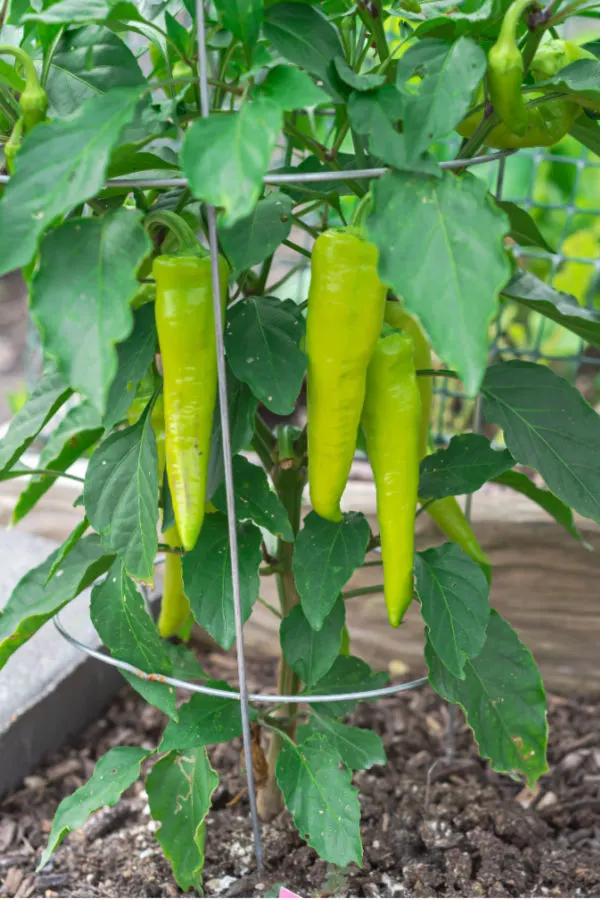When you prune the pepper plants that grow in your garden, raised beds or containers – great things happen!
When it comes to growing healthy, vibrant and extremely productive pepper plants, pruning can play a big role in the overall success of your plants. Not only can pruning your pepper plants help improve the amount of air, water and sunlight they receive for strong growth – it can also boost pollination and yields.
When the branches, stems and leaves of a pepper plant are allowed to grow at will, they can create a canopy of foliage that is so dense it becomes hard for pollinators to get to the blooms. But by opening up the plant a bit, it can increase access and pollination. In addition, the added air flow helps keeps the plant healthier and stronger too.

Pruning also makes it so much easier for gardeners to care of their plants. By trimming the lower limbs of your pepper plants off of the ground – watering, weeding and fertilizing become simple tasks. Even better, trimming up the base also makes it hard for pests to gain access. Without the lower limbs, it’s more difficult for them to climb up to the foliage.
With all of those benefits in mind, here is a look at how to prune your pepper plants to perfection. In addition, we have also added a section on why and how to stake your pepper plants. Believe it or not, staking your pepper plants is just as vital as providing support for your tomato plants!
How To Prune Pepper Plants For Better Peppers & A Bigger Harvest
Why & How To Prune Pepper Plants
Just as with tomatoes, pruning pepper plants is crucial for growing a healthy, productive crop.
When it comes to peppers, the most important area for pruning is at the bottom of the plant. In fact, even if you choose not to prune anything else, prune the bottom of your plants! As mentioned above, bottom pruning is critical when it comes to letting air work up through the plant and keeping disease and pests at bay.

For smaller pepper varieties, when mature, the bottom eight to ten inches of the plant should be trimmed up. For larger bell and roasting pepper types, there should twelve to eighteen inches clear from the bottom up.
The key to success is to trim the plant up gradually as it grows. During the first month of growth, when plants are small, begin by trimming off any branches near the bottom four to six inches.
Young stems are thin and can often be easily trimmed off with sharp, clean scissors or pruners. Making sure they are sharp and clean is important! Dull blades can easily tear the main stems and damage young plants. Affiliate Product Link: Fiskars Bypass Pruning Shears 5/8” Garden Clippers
Sterilize Before Pruning
Sterilize your blades with a antiseptic wipe before trimming to keep from transferring disease from other plants it may have been used to prune. This is important to do when performing any pruning on any plant around your landscape.
As the plant grows, continue to trim lower limbs to clear up to the desired space. The trimmings from pepper plants can be added to the compost pile as long as they show no obvious signs of disease.

Pruning The Middle & Top – How To Prune Pepper Plants For Success
The middle and top regions of your pepper plants can be helped by pruning as well, and it can be quite beneficial to their overall success. Pruning in these areas will be lighter than the bottom, but helps to keep the foliage from becoming too dense.
Allow the plant to mature a bit before middle or top pruning. Begin by clearing just a few branches from the middle of your plants to open it up. Select stems and branches that have the fewest blooms and remove to allow the remaining plant to receive more light and air.
The real key for middle pruning is to simply not allow the plant to be overgrown with foliage. Do not overthink this step and remember that less is more when it comes to middle pruning. By removing just a few middle stems and branches, it can greatly improve the plant’s air flow and ripening potential.
Finally, always remove any rogue or wild branches, or any part of the plant that shows signs of disease. If a branch grows too tall and is hard to support, you can trim it to keep the plant from becoming top heavy or hard to manage. Again, more than anything else, it is the bottom pruning that matters most!

Prune Off Early Peppers
One last bit of pruning that can help your plants is to remove the first peppers that form. Although it can be exciting to see these early peppers, by removing the first ones that appear, you keep the plant focused on growing and creating more blooms.
It can be difficult to do for gardeners, but by pruning that early fruit off, you actually will speed up your harvest. The early peppers take long too long to mature and take energy from the plant. Do this for about a week or two, and then let new blooms turn into great peppers!
Supporting Your Pepper Plants – How To Prune & Support Pepper Plants
Supporting pepper plants is just as vital as supporting your tomato plants. Without it, peppers can easily suffer – as can your total harvest!
As a pepper plant begins to grow, the stems and branches can become quite top heavy. Especially as more and more peppers form. In fact, when ripening a full crop, pepper plants produce even more weight on its branches than many tomato varieties.
Without proper support, branches can easily snap from the weight. This can not only ruin the fruit, but damage the plant in the process. And if there happens to be a high wind storm or summer rain storm, you can lose the entire plant in an instant.

For smaller varieties such as jalapeno, banana and chili peppers, you will need to stake plants to support only the the main stem. Start by tying off the main stem a few inches off the ground. Continue to tie more supports as it grows every four inches up the main stem.
These smaller plants produce their fruit in compact fashion off of the main stem, because of that, a single support is usually more then enough to secure the crop.
Supporting Large Pepper Varieties – How To Prune & Support Pepper Plants
For larger varieties such as green, red and yellow bell peppers, or large roasting pepper, staking both the main stem and heavily loaded branches is a must. Like the smaller pepper varieties, begin by tying the main stem early on a few inches up. You will also want to tie the main stem or stems as they grow every four to six inches all the way up the plant.
In addition, for large pepper varieties, you will want to tie back any heavy branches back to the main support to keep in check. Without the additional support, large offshoot branches can tear from the plant quite easily. Especially as they have more and more ripening fruit on them!
Here is to pruning and supporting your pepper crop like a pro this year. For more on growing great peppers, check out our article, How To Fertilize Pepper Plants For A Big Harvest!

Follow Our Facebook Page For Great Gardening Tips And Advice! This Is My Garden Facebook Page
This Is My Garden is a garden website created by gardeners, for gardeners. Jim and Mary Competti have been writing gardening, DIY and recipe articles and books and speaking for over 15 years from their 46 acre Ohio farm. They publish three articles every week, 52 weeks a year. Sign up today to follow via email, or follow along!
